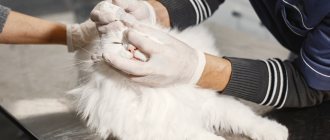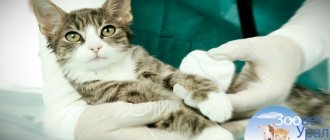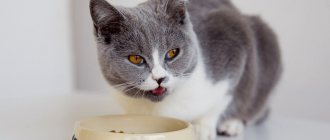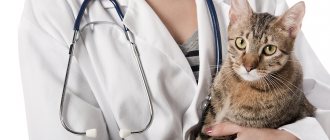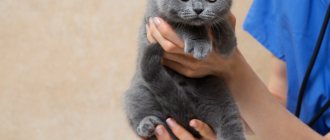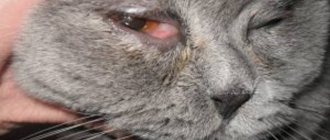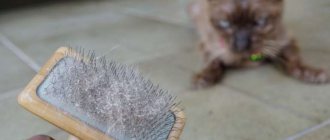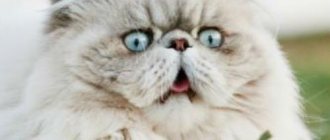You can hear sneezing not only from people, but also from pets. Our mustachioed-striped pets often sneeze when they climb into a dusty corner and dust gets into their nose, but if this happens constantly, the cat’s nose and eyes are running, he coughs, then the problem is clearly not simple and requires the intervention of specialists.
What to do if your cat sneezes? What caused it? It is these questions that we will try to answer in this material.
Why does a cat get a cold?
A cold occurs in a cat as a result of hypothermia. During contact with cold, due to drafts, the pet’s immune system malfunctions. This creates the most favorable environment for the attack of viruses and microbes. In addition to hypothermia, there are other factors that contribute to the occurrence of colds, the most common among them:
- Weakening of the immune system due to previous diseases.
- Walking in the rain and wind.
- Finding an animal in drafts.
- Change of usual food.
- Unvaccinated animals with chronic diseases suffer from colds more often.
My nose can't breathe, what should I do?
Individuals of the cat family, due to their species characteristics, are not susceptible to common colds, and the presence of a runny nose and nasal congestion is a consequence of more serious pathologies . Moreover, these diseases may have nothing to do with respiratory origin. The presence of green nasal discharge, accompanied by profuse lacrimation, may mean that the cat has developed feline herpes - rhinotracheitis .
Rhinotracheitis is an infectious disease.
The following two tabs change content below.
- About the expert:
Irina Vladimirovna Shorokhova
I am a veterinarian in one of the clinics in the city of Gomel (Belarus). I myself am an experienced cat lover, I have two Don Sphynxes. I love these animals very much and they love me back. These are charming cats - Marfa and Petrovna.
Ways of transmission of the disease
The disease cannot be ignored, since herpes can be a harbinger of more severe consequences - calcivirus, chlamydia, mycoplasmosis, immunodeficiency virus, leukemia.
The causative agent of feline herpes is the FHV-1 virus , which subsequently causes severe pathologies of the upper respiratory tract. It also provokes the development of conjunctivitis and ulcerative manifestations in the cornea.
The disease is caused by the FHV-1 virus.
Cats become infected with the virus through direct contact with infected secretions - nasal secretions, saliva, tears. Also, if there is more than one pet in the house, and they share a tray, bowl, or they often lick each other. There is also intrauterine infection. If the mother is sick, then with a high degree of probability the disease is transmitted to the kittens.
Features of rhinotracheitis
In some cases, rhinotracheitis occurs without visible symptoms, but the sick animal still poses a danger to others because it releases saliva, tears, nasal discharge, and excrement into the external environment, which ends up on the grass, soil, and puddles.
A sick cat can infect another animal through nasal discharge.
Treating a cat for sneezing
Only a veterinary specialist at the clinic can prescribe the correct treatment for a cat with symptoms of sneezing. If, during a clinical examination of your cat, a veterinarian determines that your cat is clinically healthy, he will recommend that you wet clean your apartment and use a special humidifier.
If the cause of sneezing is allergic in nature, then recommendations will be given to eliminate the allergen present in the apartment or to ensure that household chemicals are inaccessible to your cat. In order to alleviate the condition, a veterinarian will prescribe one or another antihistamine to your animal.
Possible consequences of a cold
It can be difficult for cat owners to understand that the disease is not typical for a small predator, and the complications, if left untreated, are extremely dangerous. A cat's illness rarely poses a danger to the human body, but can be transmitted to other four-legged and feathered inhabitants of the apartment.
If you ignore the primary symptoms and do not start treatment in time, the disease progresses to a serious stage.
Typical complications:
- bronchitis,
- pneumonia,
- joint damage,
- genitourinary infections.
Also, the immune system weakened by the disease is a poor “protector” for the animal. Viruses brought by the owner on street clothes and shoes can easily infect a sick body.
How does a cold manifest in cats?
Colds in cats. The symptoms of viral diseases in cats are similar, however, successful treatment is only possible with the correct diagnosis. Therefore, when your pet shows signs of a cold, you should urgently consult a specialist. Tests may be needed to determine the virus that causes the illness. Colds are more common in kittens due to their rather weak immunity. The main symptoms include:
- increased body temperature (nose becomes dry and hot)
- lack of appetite
- runny nose and sneezing
- heavy breathing, cough
- tearfulness
- apathy, etc.
Diagnostic methods
At home, it is difficult to determine the exact cause of the cat’s deterioration. You need to seek help from a veterinarian . During the diagnosis, the animal is examined, body temperature is measured, and an anamnesis is collected by interviewing the cat's owner.
The following studies are prescribed:
- general and biochemical blood test;
- Analysis of urine;
- taking swabs from the nasal cavity and throat;
- nasal endoscopy;
- X-ray of the head.
The cat has a cold and is sneezing: what to do?
If your pet is sneezing, coughing, the nose is dry and hot, the eyes are watery, there is no appetite, breathing is difficult, you should give the cat first aid.
Algorithm of actions:
- Carry out a visual inspection, analyze whether the disease is the result of a viral infection.
- Place the sick person in a comfortable, warm place, making sure there are no drafts.
- Put a heating pad on if the animal is cold.
- Give plenty of warm water and milk. Cold drinks are prohibited.
- Massage your body to increase blood circulation.
- Offer nutritious food.
If after two or three days the pet’s condition remains unchanged, you must visit a veterinary clinic, where the doctor will make an accurate diagnosis.
What is reverse sneezing?
Reverse sneezing, or reverse breathing, is an involuntary inhalation that resembles a suffocation attack. Most often it occurs in brachycephalic dogs, but is sometimes diagnosed in sphinxes and other felines. Despite the frightening picture, this condition is not a pathology and goes away on its own.
If a mustachioed pet sharply stretches its neck and begins to swallow air noisily, do not rush to get scared. A similar effect is observed when quickly absorbing food or playing too actively. The only cause for concern is too frequent attacks, accompanied by the appearance of other alarming symptoms.
Prevention
A cold is not dangerous for an animal with normal immunity, but the disease causes discomfort to the cat and is quite difficult to treat. It is much easier to prevent infection. The following measures help with this:
- Proper care of animals. For the first few weeks of life, kittens should be kept in a warm, draft-free room. Trays and sleeping places for adult animals should also not be in rooms with cold air.
- Gradual adaptation to the street. You need to start this procedure in the warm season. The cat is allowed outside for several hours. In this case, you need to ensure that the animal does not become hypothermic. In rainy and windy weather, walks are avoided.
- Proper bathing. The cat needs to be bathed with warm water. After the procedure, the fur is thoroughly dried with a towel, while the pet should be in a warm room.
- Proper nutrition. The diet should include balanced food and sufficient fluids. Do not give your cat cold food or water.
Symptoms
Before making a final diagnosis, your veterinarian must rule out other feline infections.
- Deterioration of general condition. The animal is weak, but at the same time it can move and leave the bed. A complete lack of activity in a cat signals a more serious pathological process in the body.
- Nasal discharge. The multiplication of viruses in the respiratory tract causes inflammatory processes. Nasal discharge is a protective reaction and allows the animal to get rid of the virus. When you have a cold, the discharge is clear, without any admixture of pus or blood. Changes in the nature of nasal discharge indicate that this is not a cold, but a more serious disease that requires immediate treatment under the supervision of a specialist. In the case when nasal breathing is preserved, we can talk about treating colds in cats; if the discharge does not allow breathing through the nose at all, then this signals another disease.
- Sneezing and coughing. This is another way to clear mucus from the airways.
- Discharge from the eyes. The symptom is quite rare, with severe irritation of the mucous membranes. From the outside it looks like the cat's eyes are watering.
- Decreased appetite. When an animal has a cold, it does not completely refuse food, but the amount of food consumed is significantly reduced. This is due to the weakness of the pet.
- Fever.
Preventive actions
As they say, it is better to prevent a disease than to cure it. Various preventive measures will help you avoid troubles such as sneezing and snot in your cat. One of the effective measures is vaccination! If you regularly carry out examinations and give your cat vaccinations, you can avoid allergies and other diseases of this kind. So don’t delay getting vaccinated.
Here is a list of diseases for which a cat needs regular vaccination:
- Rabies.
- Leukemia.
- Cat flu and various viral infections.
Let your pet live a fulfilling and healthy life. Do not spread illnesses , maintain hygiene and pay attention to the slightest deviation from your usual state. Give love and daily, monthly, and annual care. Prevention is better than cure. Believe me, nothing human is alien to our pets. And they also want to be strong, well-groomed, healthy and attractive to the opposite sex. So give them this opportunity!
Cat flu: symptoms
Cat flu, the symptoms and treatment of which raise many questions, has an incubation period of 2-10 days. The virus can be transmitted from a sick animal, for example, in a nursery, or from a carrier through airborne droplets. The principle of virus penetration into the body is the same as in humans - through the mucous membranes of the oral cavity and through the conjunctiva of the eyes. The contact variant is less common - through products, sleeping accessories, cups, etc.
Article on the topic Medical battalion at home. How to organize treatment for a pet
A clear sign of cat flu is a runny nose. Also among the symptoms indicating pathology are:
- sneezing;
- conjunctivitis;
- increased body temperature;
- febrile conditions.
Also, a sick cat will be tired and weak; it will eat less or refuse to eat at all. If the cat's flu is caused by a calcivirus, it is milder. The situation becomes much more complicated if a bacterial infection is added. Then the cat may develop:
- pneumonia;
- bronchitis;
- chronic rhinitis.
This situation may occur if there is an outbreak in the cat population.
The hamster has infected! What diseases are transmitted from animals to people? More details
Dangerous causes requiring special attention
- Viral, infectious and fungal diseases . Leukemia, immunodeficiency, rhinotracheitis, calicivirus and other dangerous diseases include sneezing in the list of symptoms. These diseases are fatal without timely diagnosis and treatment. At risk are kittens, pregnant and elderly animals, as well as animals picked up from the street or taken from shelters. It is important to understand that vaccination also does not provide 100% protection against infection and these diseases cannot be ruled out even in vaccinated pets!
- Tumors and polyps . If you notice that your pet has constant nasal congestion, sneezing and a runny nose, then one of the reasons may be a new growth in the nasal passage. To diagnose such a problem, you need to go to the clinic for an examination. Most likely, a rhinoscopy (using an endoscope) will be required to remove this tumor.
- Asthma . If, in addition to sneezing, your pet experiences wheezing, shortness of breath, or coughing, this may be a manifestation of asthma. In this case, you should contact the clinic for a more accurate diagnosis and prescription of medications.
- Dental problems . Often sneezing occurs due to dental problems. At the same time, the pet rubs its mouth and nose with its paws, and it often has difficulty eating. Examine your cat's oral cavity: if you notice plaque on the teeth, redness of the gums, an unpleasant odor, or drooling, you should consult a dentist.
- Worms . Infection can manifest itself in different ways, including a runny nose with wheezing. If you notice abnormal bowel movements, weight loss, dull hair, or a rounded belly, you need to get tested and treat parasites with medications recommended by your doctor.
In these cases, it is dangerous to self-medicate a runny nose; you need to go to the clinic as soon as possible.
You need to go to the vet urgently if:
- the cat sniffles, breathes with its mouth open;
- in addition to mucus, blood or pus is discharged from the nose;
- there is an increase in temperature - the pet has a hot nose and paw pads;
- there is redness of the eyes, lacrimation, and formation of pus;
- lethargy, anxiety, refusal of food and water, weight loss are manifested.
Main problems
There are many conditions characterized by sneezing and watery eyes, but some are diagnosed more often than others. It is worth considering them separately. If other significant symptoms are present, pathology can be identified and treated.
Be sure to read:
The cat has a stuffy nose: reasons, how to treat it, is it possible to use nasal drops, what will happen if the runny nose is not treated
How to tell if your cat has a cold
The cause of the disease is hypothermia of the pet. This is facilitated by a sharp temperature change. To do this, your pet just needs to play actively and then go outside during the cold season.
Swimming in cold water, jumping in the snow, and staying in the rain also contribute to the development of colds.
Characteristic features:
- cough;
- lethargy;
- conjunctivitis;
- temperature increase, but insignificant;
- lack of interest in food;
- snot.
Important! Cold symptoms are in many ways similar to other more serious pathologies, and if in doubt, you should visit a veterinarian and clarify the diagnosis.
To recover, you need to provide your pet with peace, warmth and rest. It is recommended to periodically wash your eyes and nose with a cotton swab dipped in clean water at a comfortable temperature.
If the provoking factor is reduced immunity, then it is recommended to use vitamins and immunomodulators as agreed by the veterinarian. A cold goes away within 5-7 days.
Symptoms of laryngitis
The disease is characterized by inflammation of the mucous membrane of the mouth and larynx.
The cause of development is hypothermia of the throat
The cause of development is hypothermia of the throat as a result of eating cold food from the refrigerator or water, as well as after a long stay outside in winter or exposure to acrid smoke.
Symptoms:
- dry, hysterical cough, gradually turning into a wet one;
- swelling of the oral mucosa;
- foamy discharge from the mouth after a prolonged cough;
- restless sleep;
- wheezing.
To treat laryngitis, various medications are used depending on the cause of development. Only a veterinarian will prescribe an adequate course of therapy.
Attention! Laryngitis can be a sign of deadly viruses such as rabies, so you should see a doctor if these symptoms appear.
Rhinitis in cats
Rhinitis in cats
The pathological process develops against the background of hypothermia, allergies, parasites and various infections. At the same time, the cat has difficulty breathing and constantly opens his mouth.
Additional symptoms:
- inflamed lymph nodes under the jaw;
- sniffling;
- snore;
- dyspnea;
- snort;
- decreased activity;
- lack of appetite.
It is impossible to try to treat rhinitis without knowing the cause of its occurrence. This threatens to significantly complicate the situation and deteriorate the pet’s well-being. To prescribe therapy, consultation with a veterinarian is necessary.
Sinusitis in cats
Development is caused by a viral or bacterial infection. Sinusitis appears against the background of sinusitis. Mucus accumulates in the maxillary sinuses, and when infection occurs, suppuration occurs.
First signs:
- rubbing the nose with a paw;
- purulent mucus from the nose with an unpleasant odor;
- food preferences change (the cat prefers liquid and warm food);
- mouth breathing;
- the temperature rises by 1-3 degrees.
Be sure to read:
Dry nose in a cat: reasons, what should be normal, good or bad, what to do
If sinusitis is suspected, the animal must be taken to a veterinarian and a series of tests must be carried out to confirm the disease.
Treatment is carried out with antibiotics, and in advanced cases, trepanation is used with washing the sinuses with disinfectant solutions.
Allergy
Sneezing and watery eyes may be an allergic reaction . Allergy triggers are often pollen, industrial feed, animal care products, dust, etc.
Sneezing and watery eyes may be an allergic reaction
It is important that the owner can track why the cat developed unpleasant symptoms. This will prevent contact with the allergen.
In the advanced form, additional symptoms appear in the form of:
- vomiting;
- swelling of the mucous membrane;
- skin itching;
- scratching the nose with a paw.
For treatment, antihistamines are used, which are administered orally or intramuscularly.
Polyp formation
Polyps in a cat can be either congenital or acquired due to an untreated allergy or infection. Symptoms may not appear immediately, but as the tumor grows, the pet begins to experience discomfort.
Additional signs:
- snore;
- mouth breathing;
- weight loss;
- head shaking;
- discharge from the ear;
- lack of coordination;
- depressed state.
Polyps are removed surgically. Then a course of antibiotics and corticosteroids is prescribed to prevent the inflammatory process.
Asthma
The suspected cause of asthma is allergies. The disease can be recognized by a paroxysmal dry cough and shortness of breath.
The appearance of unpleasant symptoms can also be caused by other pathologies. But only an experienced specialist can make an accurate diagnosis.
The priority treatment drugs are hormonal agents in the form of tablets, injections, and sprays. Additionally, bronchodilators are prescribed, used during attacks to expand the patency of the bronchi.
Other possible causes of runny nose and sneezing
The appearance of unpleasant symptoms can also be caused by other pathologies. But only an experienced specialist can make an accurate diagnosis.
Other provoking factors:
- foreign object;
- chlamydia;
- viral leukemia;
- immunodeficiency virus
- dental diseases.
Colds in cats: treatment and symptoms
Animals are very sensitive to drafts. They can become hypothermic, which is how colds develop in cats.
Symptoms of cold development in cats
The disease occurs with well-known symptoms:
- nose is hot,
- sneezing,
- apathy,
- coughing,
- weakness,
- The big cat's eyes are watering,
- it happens that they are partially closed when the third eyelid is inflamed.
Features of the development of colds in kittens and cats
1. It must be remembered that if a cat with cold symptoms does not have a vaccination and it sneezes, it is not an infectious disease. You need to know that viral calicevirosis or rhinotracheitis in cats always begins with the appearance of a runny nose and you can lose the animal within up to 10 days, these viruses are especially dangerous for young animals, and moreover, they are deadly.
One of the main symptoms of the disease is a runny nose, which may be one of the signs of bronchial asthma or be of allergic origin. It is necessary to carry out an accurate differential diagnosis, because the treatment is fundamentally different: corticosteroids, antihistamines.
2. All cats tolerate colds differently: in some it manifests itself in mild malaise, while in others the disease can be very severe. You should not self-medicate, relying on available home remedies.
3. If the first symptoms of a cold appear in cats, the temperature rises, you need to consult a veterinarian. The disease is treated with antibiotics, anti-inflammatory drugs, and immunomodulators. Don't give cats a cold, it can turn into pneumonia. And also, against the background of a runny nose in cats, it is quite possible that secondary bacterial infections will develop and the maxillary sinuses will become inflamed.
Principles of treating colds in cats
In the event that veterinary care is not available, it is necessary to know the sequence of treatment for colds in cats and the medications used. Here is an approximate procedure:
- inject the cat intramuscularly with Gentamicin, it is administered twice,
- Ascorbic acid tablets twice,
- Norsulfazole three times, this is the daily dose of medication
- and also Immunofan, subcutaneous injections once every two days, twice in total.
When keeping several cats, it is necessary to isolate the sick cat from the rest until the cause of the disease is finally determined.
Great attention should be paid to the prevention of colds, to prevent hypothermia of the animal, as well as to eliminate drafts, and do not forget about them when ventilating the room.
How to carry out the procedure?
It is very important to hold the cat well with a towel during any medical procedure. Because any sudden movement of the pet can cause even more harm to it.
How to do it? First you need to prepare the place for burial. It is wiped with a cotton pad previously moistened with the necessary solution. Dried purulent discharge softens and is easily removed.
The next step is to take the following steps:
- prepare medications;
- pull back the eyelid;
- instill the drug;
- after penetration of the medicine, the cat should remain motionless for about 5 minutes for good absorption of the medicine;
- pet the cat and give him treats.

